Hope Springs Eternal
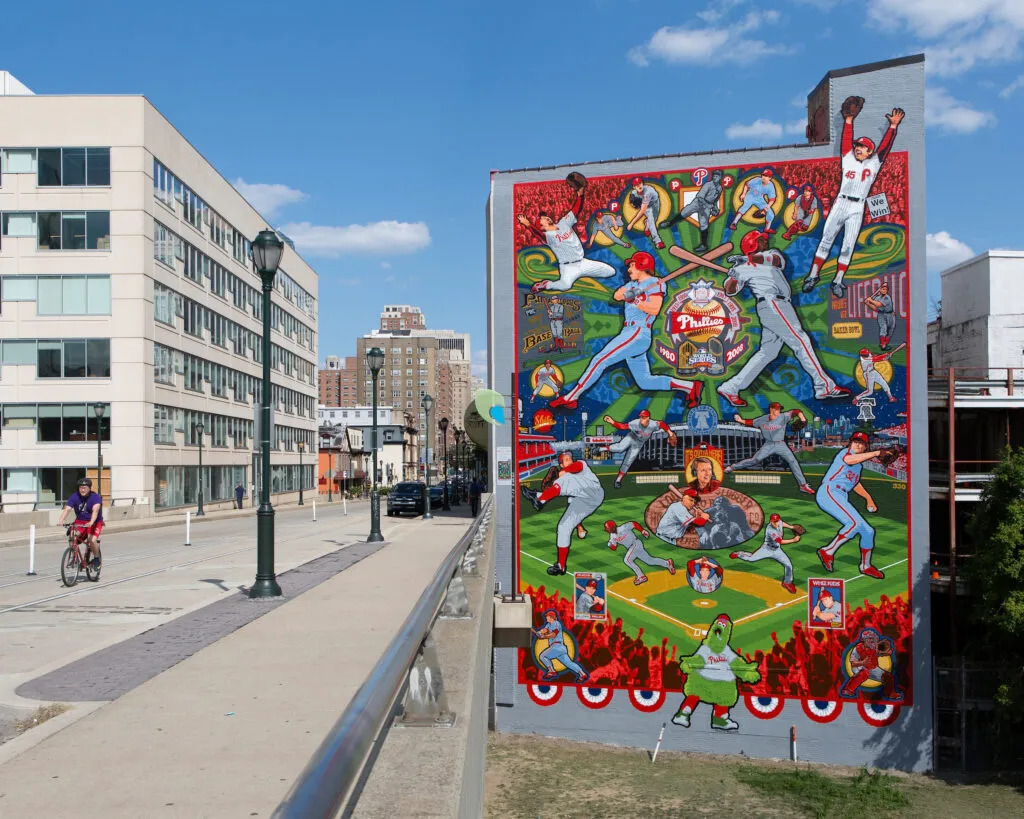
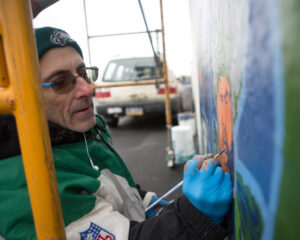
As a lifelong Phillies fan, “Hope Springs Eternal” was an expression that would float out each year after a long, cold winter, when Spring Training and Opening Day finally arrived with an air of optimism, only to be dashed most years on the rocky shores of yet another disappointing season. In their history, the Phillies have had many disappointing seasons. They were the first professional sports team in history to reach the staggering sum of 10,000 losses, and they still hold the record for most losses of all time set, not just by a professional baseball team, but by any professional team in all of sports. There were many years when the team was just flat-out terrible. Between 1918 and 1948, spanning a 30-year period, they had only one season with a winning record. They played at the Baker Bowl amid those lean years, a stadium remembered for its large outfield signboard with an advertisement for a deodorant soap that said “The Phillies Use Lifebuoy…,” and for the disheartened but loyal fans that famously would add the tagline “…but they still stink.”
And yet, the Phillies also had many good stretches, including winning seasons, playoff runs, and even World Series appearances. These were the moments that kept hope alive. And then, finally, in 1980, the Phillies won their first World Series. I was in 8th grade. My twin brother and I were the youngest of eight kids in a working-class family that didn’t have much of a budget to attend many games. But my mother liked baseball, so every once in a great while, my plumber dad would pack us all up in our Ford Fairlane station wagon, and we’d sit in the 50-cent General Admission seats at Veterans Stadium, way up in the nosebleed seats of right field. Mike Schmidt was the MVP of the team that year–considered by many to be the best 3rd baseman in Major League history. He was a remarkable home run hitter–but even the longest of his 548 career home runs wouldn’t have come anywhere close to where we sat.
So, what does all this have to do with our 2025 theme, Mural Arts – The Place Where Art Meets Hope? Well, it just so happens that 28 years after their first championship, the Phillies won their second World Series Championship in 2008. The city went nuts, and an epic celebration with a huge parade and fans climbing light posts ensued. Once again, what started as a glimmer of hope for fans ignited into a victory celebration that united the entire city, where plumbers, corporate CEOs, bank tellers, and Wawa hoagie makers all hugged and high-fived together.
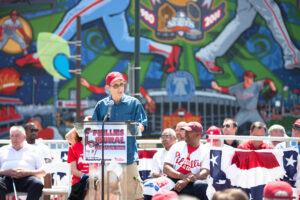
In 1995, I was an ambitious and hopeful student artist who met Jane Golden when she taught a summer mural class at the Pennsylvania Academy of the Fine Arts. I was instantly hooked by her vision of how we could help change people and places through participatory public art. With Jane’s mentorship, and with all the opportunities she created for young aspiring muralists like myself, I became a figurative muralist who had the privilege of working with many communities – such as Mantua, where we created a mural about a local hero/activist named Herman Wrice, and Point Breeze, where we created a mural that featured neighborhood icon Mamie Nichols.
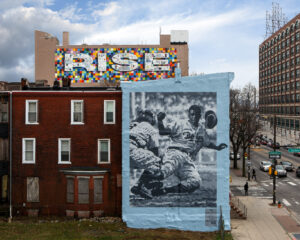
My love of baseball led me to fantastic opportunities to create murals that told the important history of Jackie Robinson and the Philadelphia Stars Negro League Baseball Team. These successes led me to become the lead artist on an annual project with the Philadelphia Eagles, where they choose a deserving elementary school in the Philadelphia School District and build a playground for the school kids, replacing a large stretch of empty asphalt with weeds growing out of the cracks. I helped to transform these schoolyards into magical playgrounds that encourage students to reach their highest potential by designing and painting murals with them on the exterior of the school buildings surrounding these playgrounds. At huge annual events, the entire Eagles team has come together each year for the past 20 years to help fill in the giant paint-by-number murals side by side with star-struck school kids.
So all this led to the Phillies Mural – an eight-story tall Center City mural highlighting not just the two World Series victories but the best moments and players in their history, where paint day events included not only hundreds of fellow fans but also some of the players we revered joining in on the painting fun–like Jimmy Rollins, Carlos “Chooch” Ruiz, and even Hall-of-Famer Mike Schmidt. It was a career highlight for me–who many years earlier started on his art journey by making sketches of sports heroes from photos clipped from newspapers and magazines during Sr. Elvira’s freshman art class at Paul VI High School. In those days, I hoped my teams would win, and I also hoped that I would get to use my talents to create meaningful artwork. So, years later, having the opportunity to create such visible landmarks, with professional players I admired, at sites that bring multitudes of diverse people together in celebration, has genuinely been a series of dream-come-true moments for me. And it all started with a little hope that went a long way.
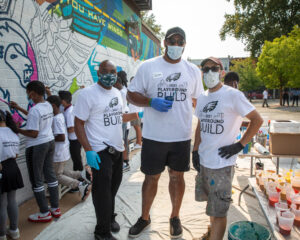
I’m celebrating my 30th year as a muralist at Mural Arts. In those years, I’ve seen many places where art meets hope. In many of the murals I have created, I’ve included drawings that school children have made–with the hope that it gives them a sense of their true significance in the ever-changing world in which we live. In the community of artists, I have mentored hundreds of creative individuals of various ages–all ambitious and hopeful–who have gone on to create great things. A fair number of them have gone on to become muralists in their own right. I’ve seen neighborhoods embrace their identities and create murals that showcase their values, significance, and dignity for all to see.
Hope is a discipline. In a world full of challenges, it is easy to get discouraged and give in, but art helps us remember our humanity and hold on to hope. To create a more just and better future, we need to be able to visualize what is possible and what such a future can look like. Artists play a vital role in that work, and communities coming together to make social change is what makes our world a better place, inch-by-inch, day-by-day, mural-by-mural—until one day we look up and realize we’ve hit it out of the park.
David McShane is the Director of Resident Artists and Senior Mural Advisor, who recently celebrated 30 years with Mural Arts. Read this recent interview with him.